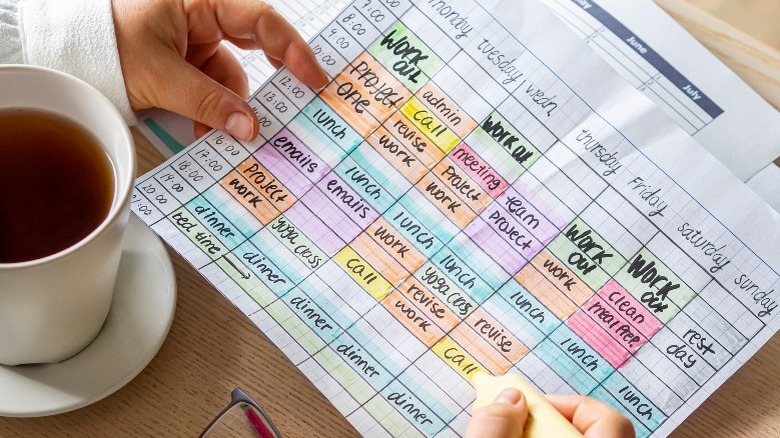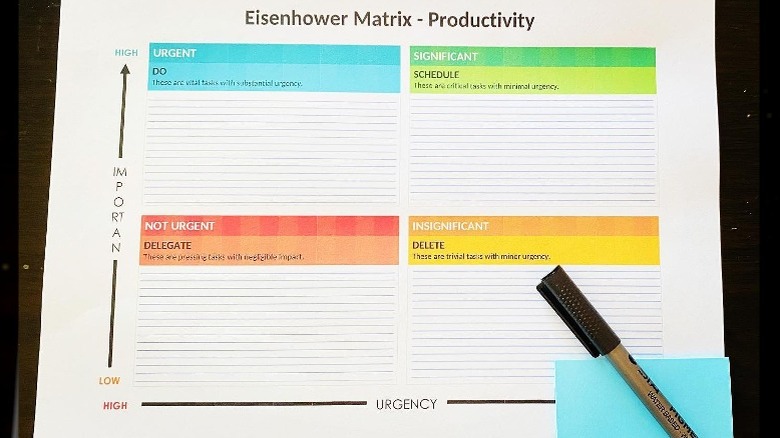5 To-Do List Alternatives If That's Just Not Your Thing
Having a to-do list can seem like having a never-ending list of things to accomplish. Some people thrive on these lists for the straightforward organization of tasks that need to be addressed, while other people enjoy the sense of accomplishment that comes with crossing off each item. But for others, to-do lists can feel like an untoward facet of adulthood that provides nothing but reminders that there is always more to be done. Yes, there are closets to declutter, emails to address, bills to pay, appointments to schedule, and so much more that is, unfortunately, essential. However, what is not required is that the organization of such matters be crafted in dotted ever-extended to-do lists.
LifeHack posits that to-do lists are notorious for their ability to cause instant, even chronic, overwhelm and anxiety, making the method an ineffective organizational technique for many people. Often, responsibilities articulated through to-do lists lack indications of priority and mix tasks related to multiple areas of life, such as professional duties and family roles, into a singular list that easily becomes a confusing cocktail of culminated responsibilities. If you've always wanted to rip up your to-do list, now you can do just that by replacing it with simple alternative methods, from time blocks and task management boards to making a game out of your responsibilities.
Tackle quick tasks on the spot
As you go about your day, you'll likely notice the few dishes still sitting in the sink, surfaces in need of wipe downs, or messages requiring replies lingering in your inbox. According to Harvard Business Review, completing several small tasks can boost your confidence and help you keep up your productivity by giving you a series of accomplishments. Experiencing minor wins without relying on to-do lists can be achieved by addressing tasks requiring no more than a few minutes to complete on the spot, rather than passing by and disregarding them.
Cleaning the cat's litter box can feel like a looming task, but rather than allowing the responsibility to hang over you and increase your stress, spend five minutes scooping the litter when you catch a glimpse — or a smelly sniff — of litter which requires changing, instead of leaving it for later. The same policy can be effective for responding to emails, tackling dirty dishes, dusting surfaces, and so on. Instead of putting tasks off, spend 10 minutes achieving small accomplishments. Don't hesitate, just do it — and do it for you!
Time blocks can derail distractions
Seeing everything you need to complete recorded in a long to-do list can make accomplishing anything feel like a hopeless feat. On the other hand, breaking those tasks down into specific time blocks can make the impossible feel possible.
Just as you'd write out your daily schedule, curate a plan with specific items assigned to unique time slots. You can choose the length of each time block to fit your schedule, though 15-minute blocks are among the most popular. Tech Funnel reports that this method is effective because when hours are broken down into 15-minute increments, there are four time blocks for four different tasks within an hour, and 32 opportunities for 15-minute time blocks in the average workday of eight hours.
The time blocking method relies on scheduled segments of time pre-assigned to tasks, rather than spontaneous completion, and can provide direction for honing your focus without distractions. Knowing you only have to focus on a task you've been dreading for 15 minutes at a time can lessen anxiety and make the task appear manageable without excess overwhelm. Stylist advises that you should prioritize including breaks and pleasurable activities into your schedule if you opt for the time blocking alternative to traditional to-do lists.
Focus on select priorities
For those who are easily overstimulated or have difficulty focusing when distractions abound, trimming the number of tasks taking up your attention can be a big help. In this alternative method of the standard to-do list, take the tasks at hand and decide on one or two priorities which are the most urgent, then focus solely on those while allowing all other tasks to exit your headspace and awareness.
This tactic is particularly helpful for people with attention-deficit hyperactivity disorder (ADHD) and other conditions which affect executive function or increase reaction to distracting stimuli, according to ADDitude. By selecting one task and focusing on nothing but that task for a set period of time, or until the task has been fulfilled, you can maintain mindful awareness in the present moment. When your mind wanders, use a predetermined word or phrase to bring your attention back to the present priority.
An important component of singular priority completion is that it works best when you're in a relaxed or neutral state. As a good rule of thumb for any task completion method, beginning when you're feeling disorganized or overwhelmed will likely produce ineffective results. Before commencing tasks, you could engage in micro-meditation to get into a state of mindfulness.
Create visual task management boards
If you respond to visual representations, you could switch up your boring old to-do list with a version that includes interesting colors and layouts. The Eisenhower Matrix is one such method, which requires drawing four quadrants to create an interactive visual board of color-coded hierarchal action items, per Asana.
Stylist advises that the four quadrants of the Eisenhower Matrix are laid out across urgency, identified as either urgent or not urgent, and importance, subsequently identified as important or not important. After splitting your piece of paper into four sections, draw a horizontal line to create a scale of urgency at the bottom of the paper, with a corresponding vertical line scaling importance along the side of the matrix. This will produce a visual organization of tasks which are important/urgent, important/not urgent, not important/urgent, and not important/not urgent.
To free you from the overwhelm of tasks to be completed, the items which fall into the not important/not urgent quadrant can typically be removed completely. After marking off the least significant quadrant, focus your immediate attention on the important/urgent quadrant, as those items are of the utmost priority.
Make a game out of action items
Just because you're an adult, it doesn't mean you have to go through your day checking off tasks one by one in a monotonous rhythm. Instead, tap into your youthful energy, competitive side, and adventurous nature by turning your completion of tasks into a series of games. Unleash your creativity by devising your own games to either compete against yourself, or make it a household activity to challenge one another in timed chore completion. You might like to try role playing as silly characters as you clean, or engaging in a tournament of your devising.
Seattle YMCA suggests giving each task an assigned number and rolling dice, then undertaking the task corresponding to the number produced by the dice roll. Another recommendation is playing freeze games, during which everyone engages in household chores but freezes at the pause of music being played. Lean into all of your goofiness and have fun pretending to be Mary Poppins, the famed nanny with magical powers, or a character of your choosing by dressing up to enjoy an experience of task completion that's completely out of the ordinary!
On your own, race yourself to see how many emails you can check off from your overflowing inbox before a timer goes off. Once you've accomplished tasks, celebrate by rewarding yourself. You deserve it!





